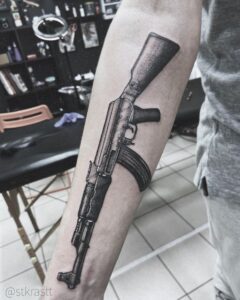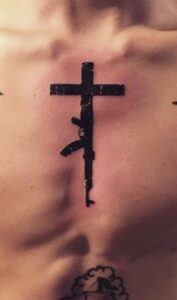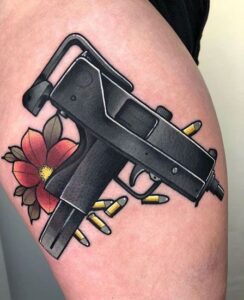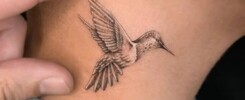Tattoo Guns: The Essential Tools for Body Art Mastery
Tattooing has evolved from a niche art form into a global cultural phenomenon. Central to this evolution are tattoo guns, the essential tools that have enabled artists to create intricate designs on human skin. Understanding the role, history, and nuances of tattoo guns is crucial for both aspiring tattoo artists and enthusiasts. In this article, we will explore the history of tattoo guns, their positive and negative aspects, and their significance in the world of tattooing.


The History of Tattoo Guns
Tattoo guns, also known as tattoo machines, have a rich history that dates back to the late 19th century. The first electric tattoo machine was patented by Samuel O’Reilly in 1891. O’Reilly’s invention was inspired by Thomas Edison’s autographic printing pen, which was initially designed for duplicating documents. By modifying Edison’s design, O’Reilly created a device capable of puncturing the skin and injecting ink, laying the foundation for modern tattooing.
Before the invention of tattoo guns, tattoos were applied manually using hand tools. This process was not only time-consuming but also less precise, making O’Reilly’s invention revolutionary. The tattoo gun allowed for faster, more consistent, and more detailed work, leading to a significant increase in the popularity of tattoos.
Over the years, tattoo guns have undergone numerous improvements. Today, there are several types of tattoo guns available, including coil machines, rotary machines, and pneumatic machines. Each type has its unique characteristics and is used for different tattooing techniques, allowing artists to achieve a wide range of effects.


How Tattoo Guns Work
Tattoo guns work by rapidly moving a needle in and out of the skin, injecting ink into the dermis layer. This process creates permanent designs that can last a lifetime. The needle in a tattoo gun is attached to a bar, which is moved by an electromagnetic coil or a motor, depending on the type of machine. The needle punctures the skin at a high speed, depositing ink with each puncture.
There are two main types of tattoo guns: coil and rotary. Coil machines use electromagnetic coils to move the needle bar up and down. They are known for their distinctive buzzing sound and are favored by many traditional tattoo artists for their power and precision. Rotary machines, on the other hand, use a motor to move the needle. They are generally quieter and smoother, making them ideal for more delicate work.
Pneumatic tattoo machines are less common but offer a different approach. These machines use compressed air to power the needle, resulting in a lightweight and versatile tool. Each type of tattoo gun has its advantages and disadvantages, and the choice often comes down to the artist’s preference and the specific needs of the tattoo design.

The Role of Tattoo Guns in Modern Tattooing
Tattoo guns have become indispensable tools in the modern tattooing process. They allow artists to create detailed, precise designs quickly and efficiently. The versatility of tattoo guns means that they can be used for a wide range of styles, from fine lines to bold shading and intricate color work.
The advancement of tattoo guns has also led to the development of more sophisticated techniques. For example, the introduction of rotary machines has made it easier to create smooth gradients and subtle shading, which are essential for realistic and portrait tattoos. Similarly, the power and precision of coil machines have made them the go-to choice for traditional and neo-traditional tattoo styles.
Tattoo guns have also played a crucial role in the professionalization of the tattoo industry. With the right tools, artists can consistently produce high-quality work, leading to greater recognition of tattooing as a legitimate art form. The availability of advanced tattoo guns has also encouraged more people to pursue tattooing as a career, leading to a vibrant and diverse community of artists.


The Positive Aspects of Tattoo Guns
One of the most significant positive aspects of tattoo guns is their ability to produce highly detailed and precise designs. The rapid movement of the needle allows artists to create intricate patterns and fine lines that would be impossible to achieve with traditional hand tools. This precision is particularly important for modern tattoo styles, such as realism and hyperrealism, where accuracy is crucial.
Tattoo guns also offer a significant advantage in terms of speed. Traditional hand-poked tattoos can take hours or even days to complete, depending on the size and complexity of the design. In contrast, a tattoo gun can complete the same design in a fraction of the time, making the process more efficient for both the artist and the client. This efficiency has contributed to the growing popularity of tattoos, as people are more likely to get a tattoo when the process is quicker and less painful.
Another positive aspect of tattoo guns is their versatility. Different types of tattoo guns can be used for various techniques, such as lining, shading, and coloring. This versatility allows artists to experiment with different styles and techniques, pushing the boundaries of what is possible in tattooing. Additionally, the availability of different needle configurations and machine settings means that artists can tailor their tools to suit their individual preferences and the needs of each client.


Tattoo guns have also contributed to the professionalization of the tattoo industry. With the right training and equipment, artists can produce consistently high-quality work, which has helped to elevate the status of tattooing as a legitimate art form. The widespread availability of tattoo guns has also made it easier for aspiring artists to enter the industry, leading to a more diverse and innovative community of tattoo professionals.
The Negative Aspects of Tattoo Guns
Despite their many advantages, tattoo guns also have some drawbacks. One of the most significant is the potential for skin damage. Because tattoo guns puncture the skin at high speeds, there is a risk of overworking the skin, which can lead to scarring or blowouts. A blowout occurs when the ink spreads beyond the intended area, creating a blurred or distorted appearance. This is more likely to happen when the tattoo gun is used improperly or when the skin is particularly sensitive.
Another negative aspect of tattoo guns is the risk of infection. The process of tattooing involves breaking the skin, which creates an entry point for bacteria and other pathogens. If the tattoo gun is not properly sterilized, or if proper aftercare is not followed, there is a risk of infection. In severe cases, infections can lead to complications such as abscesses or even systemic infections. This highlights the importance of using high-quality, sterilized equipment and following proper hygiene practices.

The noise and vibration produced by coil tattoo guns can also be a drawback for some artists and clients. The constant buzzing sound and the vibration of the machine can be uncomfortable, especially during long tattoo sessions. Rotary machines are generally quieter and produce less vibration, but they may not be suitable for all types of tattooing. The choice between coil and rotary machines often comes down to personal preference, but it is important to consider the comfort of both the artist and the client.
Another potential drawback of tattoo guns is their cost. High-quality tattoo guns can be expensive, and artists may need to invest in multiple machines to achieve the desired results. In addition to the cost of the machines themselves, there are also ongoing expenses for needles, ink, and other supplies. For aspiring tattoo artists, the initial investment can be a significant barrier to entering the industry.
The Evolution of Tattoo Guns: A Look at Modern Innovations
Tattoo guns have come a long way since Samuel O’Reilly’s first electric tattoo machine. Modern tattoo guns are the result of decades of innovation and refinement, with new technologies constantly being developed to improve the tattooing process.
One of the most significant innovations in recent years is the development of wireless tattoo guns. These machines eliminate the need for power cords, giving artists more freedom of movement and reducing the risk of accidental disconnections during the tattooing process. Wireless tattoo guns are powered by rechargeable batteries and offer a level of convenience that was previously unavailable with traditional machines.


Another modern innovation is the use of digital displays and controls on tattoo guns. Some high-end machines now feature digital interfaces that allow artists to precisely control the speed, voltage, and other settings of the machine. This level of control can lead to more consistent results and allows artists to fine-tune their machines to suit their specific needs.
The materials used in tattoo guns have also evolved over time. While early machines were made from heavy metals, modern tattoo guns are often constructed from lightweight materials such as aluminum or carbon fiber. This reduces the strain on the artist’s hand and allows for longer tattoo sessions without fatigue.
In addition to these technological advancements, there has also been a growing focus on ergonomic design in tattoo guns. Manufacturers are increasingly designing machines with the artist’s comfort in mind, incorporating features such as adjustable grips and balanced weight distribution. These ergonomic improvements can help prevent repetitive strain injuries and make the tattooing process more comfortable for both the artist and the client.
The Cultural Significance of Tattoo Guns
Tattoo guns are more than just tools; they are symbols of the artistry and craftsmanship that go into creating tattoos. For many tattoo artists, their tattoo gun is a personal and essential part of their creative process. The type of machine an artist uses can be a reflection of their style, technique, and artistic philosophy.
Tattoo guns have also played a role in the broader cultural acceptance of tattoos. As tattooing has become more mainstream, the tools of the trade have become more visible and recognized. Tattoo guns are now featured in popular media, from movies and television shows to music videos and social media. This increased visibility has helped to demystify the tattooing process and has contributed to the growing acceptance of tattoos in society.


For tattoo enthusiasts, the sound of a tattoo gun can be a comforting and familiar reminder of the tattooing experience. The distinctive buzz of a coil machine or the hum of a rotary machine is often associated with the anticipation and excitement of getting a new tattoo. This auditory connection between the tattoo gun and the tattooing experience has become ingrained in the culture of tattooing. For many, the sound is part of the ritual, signaling the beginning of a new piece of body art and the continuation of their personal journey with tattoos.
The Impact of Tattoo Guns on Tattooing Techniques
The evolution of tattoo guns has significantly impacted the techniques used in tattooing. With the precision and speed that modern machines offer, artists can now execute more complex designs with greater detail and shading than ever before. Techniques such as fine line work, dot work, and intricate shading have been made possible largely due to advancements in tattoo gun technology.
The precision offered by tattoo guns has also enabled the development of new styles. For instance, the photorealistic style, which seeks to replicate the appearance of photographs on the skin, relies heavily on the ability of tattoo guns to create smooth gradients and fine details. Without the precise control provided by modern machines, such detailed and realistic tattoos would be far more challenging to achieve.


Tattoo guns have also made it easier to blend colors and create smooth transitions between different shades, which is essential for creating tattoos with depth and dimension. This has opened up new possibilities for artists, allowing them to experiment with more complex color palettes and achieve more vibrant, lifelike results.
The Importance of Proper Maintenance and Hygiene
Tattoo guns require regular maintenance to ensure they function correctly and safely. Proper care involves cleaning the machine after each use, lubricating moving parts, and regularly replacing worn components like needles and rubber bands. This not only extends the life of the tattoo gun but also ensures that the machine operates smoothly, providing consistent results.
Hygiene is also a critical aspect of using tattoo guns. Since the process involves breaking the skin, there is always a risk of infection if the equipment is not properly sterilized. Tattoo studios must adhere to strict hygiene protocols, including the use of disposable needles and tubes and the sterilization of reusable parts in an autoclave.
Artists must also be trained in proper hygiene practices to minimize the risk of infection for their clients. This includes wearing gloves, using single-use ink caps, and cleaning the skin thoroughly before starting a tattoo. Ensuring that all equipment is sterile and that proper procedures are followed is essential for the safety and well-being of both the artist and the client.


Tattoo Guns and the Future of Tattooing
As technology continues to advance, the future of tattoo guns looks promising. Innovations in materials, design, and functionality will likely continue to improve the tattooing process, making it even more efficient, precise, and comfortable for both artists and clients. The development of more advanced machines may also open up new possibilities for tattooing techniques and styles, further expanding the artistic potential of this medium.
One area of potential growth is the integration of digital technology with tattoo guns. For example, future machines could incorporate smart technology that allows artists to track their usage, monitor machine performance, and even connect to software that assists with design and execution. This could lead to more consistent results and reduce the learning curve for new artists.
Another exciting possibility is the continued development of wireless tattoo guns. As battery technology improves, we can expect to see more powerful and long-lasting wireless machines that offer even greater freedom of movement for artists. This could revolutionize the way tattoos are done, making the process more accessible and convenient.

The future may also bring new materials and designs that make tattoo guns lighter, more ergonomic, and easier to use. As the demand for tattoos continues to grow, manufacturers will likely focus on creating machines that meet the needs of both experienced artists and newcomers to the industry.
The Enduring Legacy of Tattoo Guns
Tattoo guns have come a long way since their invention in the late 19th century. From their humble beginnings as modified versions of Edison’s autographic printing pen, they have evolved into highly sophisticated tools that are essential to the modern tattooing process. The advancements in tattoo gun technology have enabled artists to push the boundaries of their craft, creating more detailed, precise, and vibrant tattoos than ever before.
While tattoo guns have their challenges, such as the potential for skin damage and the need for proper hygiene, their benefits far outweigh the drawbacks. They have played a crucial role in the professionalization of the tattoo industry, helping to elevate tattooing to a respected and widely accepted art form.


As we look to the future, it is clear that tattoo guns will continue to play a central role in the evolution of tattooing. With ongoing innovations and improvements, these tools will likely become even more versatile, precise, and user-friendly, opening up new possibilities for artists and expanding the horizons of what can be achieved with tattoos.
For anyone interested in tattooing, whether as an artist or a client, understanding the history and significance of tattoo guns is essential. These tools are not just instruments of the trade; they are a testament to the ingenuity and creativity that have shaped the world of tattooing for over a century. As the art of tattooing continues to evolve, tattoo guns will remain at the heart of this dynamic and ever-changing field, enabling artists to create works of art that are as enduring as the human spirit itself.




